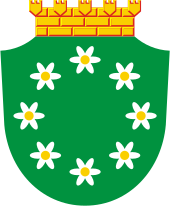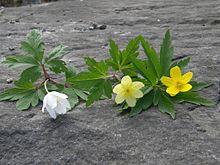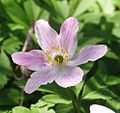
Geranium is a genus of 422 species of annual, biennial, and perennial plants that are commonly known as geraniums or cranesbills. They are found throughout the temperate regions of the world and the mountains of the tropics, with the greatest diversity in the eastern part of the Mediterranean region.

Anemone is a genus of flowering plants in the buttercup family Ranunculaceae. Plants of the genus are commonly called windflowers. They are native to the temperate and subtropical regions of all continents except Australia, New Zealand and Antarctica. The genus is closely related to several other genera including Anemonoides, Anemonastrum, Hepatica, and Pulsatilla. Some botanists include these genera within Anemone.

Ficaria verna, commonly known as lesser celandine or pilewort, is a low-growing, hairless perennial flowering plant in the buttercup family Ranunculaceae native to Europe and Western Asia. It has fleshy dark green, heart-shaped leaves and distinctive flowers with bright yellow, glossy petals. It is now introduced in North America, where it is known by the common name fig buttercup and considered an invasive species. The plant is poisonous if ingested raw and potentially fatal to grazing animals and livestock such as horses, cattle, and sheep. For these reasons, several US states have banned the plant or listed it as a noxious weed. It prefers bare, damp ground and is considered by horticulturalists in the United Kingdom as a persistent garden weed; nevertheless, many specialist plantsmen, nursery owners and discerning gardeners in the UK and Europe collect selected cultivars of the plant, including bronze-leaved and double-flowered ones. Emerging in late winter with flowers appearing late February through May in the UK, its appearance across the landscape is regarded by many as a harbinger of spring.

Delphinium is a genus of about 300 species of annual and perennial flowering plants in the family Ranunculaceae, native throughout the Northern Hemisphere and also on the high mountains of tropical Africa. The genus was erected by Carl Linnaeus.
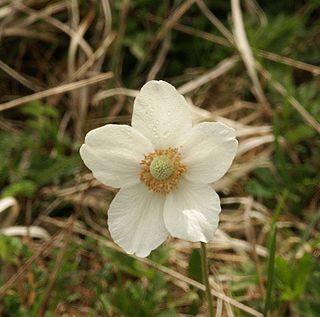
Anemonoides sylvestris, known as snowdrop anemone or snowdrop windflower, is a perennial plant flowering in spring, native to meadows and dry deciduous woodlands of central and western Europe and temperate Asia. It forms spreading patches, sometimes aggressively spreading.
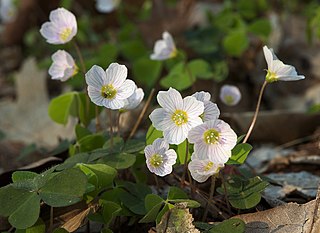
Oxalis acetosella, the wood sorrel or common wood sorrel, is a rhizomatous flowering plant in the family Oxalidaceae, common in most of Europe and parts of Asia. The specific epithet acetosella refers to its sour taste. The common name wood sorrel is often used for other plants in the genus Oxalis. In much of its range it is the only member of its genus and hence simply known as "the" wood sorrel. While common wood sorrel may be used to differentiate it from most other species of Oxalis, in North America, Oxalis montana is also called common wood sorrel. It is also known as Alleluia because it blossoms between Easter and Pentecost, when the Psalms which end with Hallelujah are sung.

Commonly known as hellebores, the Eurasian genus Helleborus consists of approximately 20 species of herbaceous or evergreen perennial flowering plants in the family Ranunculaceae, within which it gave its name to the tribe of Helleboreae. Despite names such as "winter rose", "Christmas rose" and "Lenten rose", hellebores are not closely related to the rose family (Rosaceae). Many hellebore species are poisonous.

Anemonoides ranunculoides, the yellow anemone, yellow wood anemone, or buttercup anemone, is a species of herbaceous and perennial plant that grows in forests across Europe to western Asia, and less frequently in the Mediterranean region. It is occasionally found as a garden escape.

Thalictrum is a genus of 120-200 species of herbaceous perennial flowering plants in the buttercup family, Ranunculaceae, native mostly to temperate regions. Meadow-rue is a common name for plants in this genus.

Anemone coronaria, the poppy anemone, Spanish marigold, or windflower, is a species of flowering plant in the buttercup family Ranunculaceae, native to the Mediterranean region.
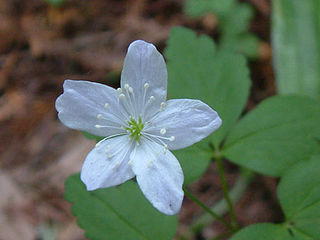
Anemonoides quinquefolia, a flowering plant in the buttercup family Ranunculaceae, is native to North America. It is commonly called wood anemone or windflower, not to be confused with Anemonoides nemorosa, a closely related European species also known by these common names. The specific epithet quinquefolia means "five-leaved", which is a misnomer since each leaf has just three leaflets. A plant typically has a single, small white flower with 5 sepals.

Campanula glomerata, known by the common names clustered bellflower or Dane's blood, is a species of flowering plant in the genus Campanula, belonging to the family Campanulaceae. It is the county flower of Rutland, England.

Anemonoides trifolia, the three-leaved anemone, is a perennial herbaceous plant in buttercup family (Ranunculaceae).

Anemone hepatica, the common hepatica, liverwort, liverleaf, kidneywort, or pennywort, is a species of flowering plant in the buttercup family Ranunculaceae, native to woodland in temperate regions of the Northern Hemisphere. This herbaceous perennial grows from a rhizome.

Anemone hortensis, commonly called broad-leaved anemone, is a perennial herbaceous flowering plant with an underground rhizome, in buttercup family Ranunculaceae. The genus name comes from the Greek ἄνεμος, as an ancient legend tells that the flowers open only when the wind blows. The species name hortensis refers to the easiness with which this plant can be cultivated.

Anemonoides is a genus of flowering plants in the buttercup family Ranunculaceae. Plants of the genus are native to the temperate regions of the Northern Hemisphere, on the continents of North America, Europe, and Asia. The generic name Anemonoides means "anemone-like", a reminder that many of the species were formerly included within the genus Anemone.

Anemonoides oregana is a species of flowering plant in the buttercup family known by the common names blue windflower, Oregon anemone, and western wood anemone. It is native to the forests of Washington, Oregon, and northern California in western North America, generally below 7,000 feet (2,100 m) elevation.

Eriocapitella hupehensis, a species of flowering plant in the buttercup family Ranunculaceae, is native to Asia. The specific epithet hupehensis, which means "from Hupeh province, China", refers to a region where the species is known to occur. In Chinese, it is called dǎ pò wǎn huā huā (打破碗花花), which means "broken bowl flower".

Anemonoides blanda, syn. Anemone blanda, the Balkan anemone, Grecian windflower, or winter windflower, is a species of flowering plant in the family Ranunculaceae. The species is native to southeastern Europe and the Middle East. The specific epithet blanda means "mild" or "charming". The genus name is derived from the Greek word anemos, or wind.

Anemonoides apennina, the Apennine anemone or blue anemone, is a flowering plant in the family Ranunculaceae. It is a rhizomatous perennial plant, native to southern central Europe, taking its name from the Apennine Mountains, but widely naturalised elsewhere in Europe, including the United Kingdom. It can be confused with Anemonoides nemorosa which it resembles. It grows to 20 cm. In early spring it produces single blue flowers above ferny foliage, which dies down in summer. The flowers are about 3.5 cm across, with 10-15 narrow petals. The leaves are palmate with dark green 3-lobed, toothed leaflets. The leaves are hairy underneath, which is how this plant may be distinguished from the similar Anemone blanda. It is especially valued for its ability to colonise deciduous woodlands, but it is also found in open scrub, under park trees, and near former habitation. This plant has gained the Royal Horticultural Society's Award of Garden Merit.



